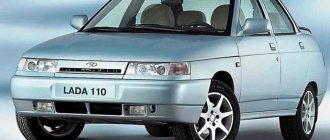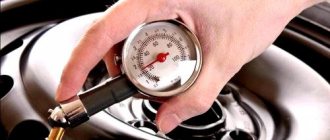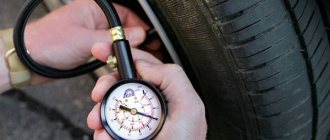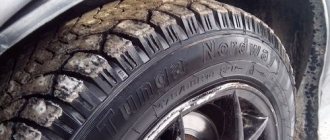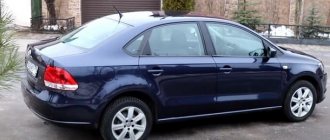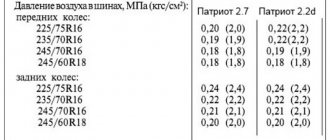When operating the car without a full load, it is recommended to inflate the tire pressure of the VAZ 2114 to 1.9 atm in the summer. When the car moves with a large number of passengers and cargo, the inflation rate in the wheels increases to 2.0. This applies to any season. In winter, the pressurization of the slopes in a warm room should be carried out 0.2 atmospheres above normal. In frosty weather, the pumping will decrease by this amount.
Correct pressure in Lada tires allows the driver to get rid of a number of troubles. When driving on lowered wheels, it is more difficult to control the car, the stability of the car is reduced, the steering wheel is difficult to turn and the tread wears out more.
If the tires are overinflated, the load on the front suspension increases, the slopes wear unevenly and there is a possibility of a sharp rupture.
Pressure in tires R13 VAZ 2114 in winter and summer
If the vehicle has 13-size rollers, then wheels of this diameter (radius) must adhere to the following inflation standards:
- In summer weather, the front and rear tires should be inflated to 1.9 atm.
- In winter the pressure should also be 1.9. Tires should be inflated to 2.1 atm. This is due to the fact that in frosty weather the boost drops by 0.2.
- In hot weather, air compression automatically increases, so it is recommended to reduce it by 0.1 atm before leaving, or forget and ride with one inflation option around 1.9 all seasons.
- If the weather is bad, keep your tire inflation at 1.8 atm. This improves the contact between the rubber and the wet surface.
- When the car is fully loaded, keep 2.1 atm in front and 2.3-2.4 atm in the rear.
When driving the car on asphalt, inflate the wheels to optimal values at 1.9 -2.0.
Optimal tire inflation for various situations
In this section we will talk about what pressure should be in the tires of a VAZ 2114 passenger car with a 14 radius in the summer and why. This information applies to wheels of other sizes, taking into account that the larger the rim diameter, the more the tire needs to be inflated. Increasing the size by 1 inch (instead of R13, put R140), increases the requirement for air compression inside the tire by 0.1–0.2 atm.
In summer on a dry asphalt road
To drive on a dry asphalt road and air temperature above +10 degrees and a standard load (5 people, each weighing 70 kg and 50 kg of cargo), the tires of a VAZ 2114 13 radius passenger car in summer should have a pressure of 2–2.2 atm in the front and 2 ,2–2.4 atm at the rear.
This combination will ensure maximum controllability and stability, as well as low fuel consumption, while some increase in chassis rigidity will be compensated by a smooth road surface.
If you plan to drive with minimal load, then the tires of a VAZ 2110 passenger car with a 14 radius in summer should have a pressure of 2 atm in the front and 1.9 atm in the rear. Sometimes such vehicles are used to transport heavy materials, several hundred kg exceeding the official carrying capacity of the vehicle.
If you have to do this, inflate the wheels 0.1–0.2 atm more, and there should be more air in the rear axle tires than in the front wheels.
Why is pressure important?
Summer on a wet road
A wet road is much more dangerous than a dry one, not only because of less grip on the wheel, but also because of the difference in water level, from slight humidity to depths of more than 1 mm. When driving through a puddle, even of this depth, there is a high probability of aquaplaning, when water lifts the tire above the road and completely deprives it of traction.
Therefore, before driving on a wet road, especially if you have to drive through an area where it rains in places, then lower the tire by 0.2–0.4 atm, this will increase the contact patch, and also reduce the specific pressure and reduce the risk of going into aquaplaning mode.
Any time of year on a dirt road
The main difference between dirt and asphalt roads is that the first does not have a flat surface, therefore, to drive on it, the pressure in the tires of a VAZ 2110 and other models must be approximately 0.5 atm lower than for asphalt.
On an uneven road, a wheel with less air compression better fits the uneven surfaces, which increases traction and therefore improves controllability and stability. A slight increase in fuel consumption is not critical, because on such a surface you have to drive in a lower gear, which automatically increases fuel consumption.
Machine wheel
On snowy or icy surfaces
In winter, ice and snow separate the tread from the road surface, causing traction to decrease dramatically. Therefore, in particularly difficult conditions, the pressure in the tires of a VAZ 2114 car should be 1–1.2 atm, this will sharply increase tire wear, but will allow you to drive through a snowy area, after which the tires need to be inflated. In addition, the narrowest R14 wheels and tires are best suited for driving on snow and ice, so it is advisable to use them in the northern regions.
For transporting a trailer
If you plan to use your Lada as a tractor and transport a loaded trailer with it, then in the summer the tires of a VAZ 2110 passenger car with a 14 radius should have a pressure of 2–2.2 atm front and rear.
This compression of air in the tires will ensure sufficient adhesion of the rubber to the road, thereby reducing tire wear and reducing tread slippage.
The speed of movement when transporting a trailer is limited to 70 km/h, so there is no point in focusing on stability and controllability, because in this mode the risk of skidding, even with the wrong maneuver, is small.
Tire pressure R14 Lada 2114
When installing 14-diameter ramps on a car, take into account the individual characteristics of the rubber:
- If the ambient temperature rises to +25 degrees, then the pressure during movement will increase by 0.8 atm.
- If, on the contrary, it drops to -25, then the pumping value will decrease by 0.8.
Please take this information into account when driving in hot or frosty weather. Optimal inflation in summer on all wheels 2114 - 2.0 atm. It is necessary to inflate the tires to the same extent when driving on asphalt in good weather.
In winter, the pressure should correspond to the norm - 2.0 atm. It is better to inflate tires in the cold. After performing the procedure in the garage, deliberately overinflate the wheels by 0.1-0.2 atm. During the trip, the pressure will return to normal.
During a bad trip on wet asphalt or primer, it is better not to inflate the rollers by 0.1 atm relative to the norm in order to achieve the optimal tightness of the tire to the road surface. In clear weather, driving on a flat road, the pressure should correspond to level 2.0.
Having completely filled the car in the summer, apply 2.1 atm to the front. Inflate the rear tires to 2.3.
The impact of tire pressure on safety
It is impossible not to evaluate the correctness of tire inflation, because this has a significant impact on the condition of the vehicle’s components, as well as on the safety of the driver, his passengers and other road users.
- If the tires are inflated differently, not corresponding to the values specified in the vehicle's passport, then the car may behave unpredictably while driving.
- When too much air is pumped into the wheels and the pressure goes off scale, there is a high probability of a tire rupture. And when driving, the braking distance increases greatly, and dynamic performance worsens.
- A lack of air is no less dangerous, especially in the cold season, as the car’s stability and cornering deteriorate, and problems with extreme braking also arise. The pressure in VAZ tires in winter should be slightly higher than in summer.
Winter tires
All this leads to serious consequences and terrible accidents.
- Improperly inflated tires wear out faster.
- Since the dynamics of the car deteriorate, more fuel is consumed as a result.
- Driving becomes worse, especially in winter and on wet surfaces.
- The quality of braking suffers.
- There is a high probability of damage to the suspension when falling into potholes on the road.
You cannot over-inflate or under-inflate the wheels. This could result in someone's death or serious damage. Particular attention should be paid to fans of Lada cars, which are not known for their safety.
Table of pressure standards in slopes
For 2114 are presented in the table.
| Rubber diameter | Summer, pressure in atm | Winter | Under load | Good weather | Bad weather | Asphalt | Primer or sand | |
| front | rear | |||||||
| R13 | 1,9 | 1,9 | 2,1 | 2,3-2,4 | 1,9 | 1,8 | 1,9 | 1,8 |
| R14 | 2,0 | 2,0 | 2,2 | 2,4 | 2,0 | 1,9 | 2,0 | 1,9 |
| R15 | 2,0-2,2 | 2,0-2,2 | 2,2 | 2,4 | 2,0-2,2 | 1,9-2,1 | 2,0-2,2 | 1,9-2,1 |
The parameters are specified by the manufacturer, it is advisable to comply with them.
What are the dangers of deviation from the norm?
In summer, due to high temperatures, the contact area between rubber and the road surface is significantly reduced. The pressure rises, and this is already an alarm bell for the driver. After all, rubber loses its elasticity and does not resist impact loads.
Plus, if you overdo it and overinflate the wheels, you can experience the following troubles while driving a car:
- Wear on the car's chassis increases, the ride becomes uncomfortable, and all the imperfections in the road surface are felt.
- The contact area of the tires with the road is reduced - the braking distance increases.
- During high-speed driving, rubber may rupture, which in itself is not safe.
If, on the contrary, the tires are poorly inflated, the following consequences will emerge:
- Vehicle controllability will deteriorate significantly.
- The amount of fuel consumed will increase.
- On snowy or wet asphalt, the car will have a tendency to skid.
- The vehicle's power will noticeably decrease.
Experienced motorists can visually determine whether tire pressure is normal or not. Beginner car enthusiasts are recommended to take measurements at least once a week. It is enough to arm yourself with a pressure gauge, reset its readings to zero, connect the fitting of the device to the nipple and start applying pressure. Then record the readings of the instrument needle.
What pressure should be maintained in the summer tires of VAZ 2108-2115 cars?
If the wheel is not inflated enough, ride comfort increases, because less vibration is transmitted to the suspension, but due to the contact patch being too large, fuel consumption increases.
Underinflated or overinflated wheels negatively affect the car’s behavior on the road, so the tires of a VAZ 2110 passenger car with a 14 radius in summer should have a pressure of 2–2.4 atm (bar). However, a more accurate value can only be determined taking into account operating conditions.
What determines wheel inflation/pressure in R13 winter tires?
The difference in the degree of tire inflation depends on the basic parameters of the car:
- Gross vehicle weight with or without loading. With a loaded car, the wheels are pushed through more than with an empty trunk and driver.
- Cylinder dimensions. Tire cavity capacity is of primary importance. For example, the pressure in winter tires R13 VAZ 2106 and R 16 on Vesta will differ by an average of 0.4 BAR.
- Speed index. At high speeds and driving on smooth asphalt, an improved free run is required. At the same time, for off-road modifications – this is not necessary.
Which wheels to choose: with or without a tube?
In recent years, tire fitting and car repair specialists have been advising the purchase of tubeless wheels. But just a decade ago it seemed fantastic. Today, the use of tires with tubes is a rare occurrence, and in a couple of years, wheels with a tube inside will probably only be found on bicycles.
A tubeless tire has better wear-resistant characteristics due to increased vulcanization. Due to their lighter weight, their technical characteristics are better due to lower inertia. In addition, a tubeless tire balances better. Their service life is also longer. In addition, in the event of a puncture, the tubeless tube will hold air longer, which will allow you to safely get to the service center.
Also, we will not consider the issue of driving in winter on winter tires with studs and greater tread depth, because... this affects your safety and the safety of not only the car, but the life and health of others. Therefore, in the summer we use summer wheels and no “all-season” tires during other periods, unless you live in snowless Europe. The choice of tire manufacturer brand is your choice; the only thing worth paying attention to is that the radius of the wheels must exactly match that recommended in the vehicle’s service book.
Review of the best summer and winter tires
Using tires that suit the seasons will save fuel and make driving more comfortable. The best choice for summer driving would be the Toyo Nano Energy 3. This version of the wheel is characterized by a relatively low noise level and fuel efficiency. However, on wet roads the braking distance is relatively long.
Yokohama Bluearth AE01 will cost relatively inexpensively - about 3 thousand rubles for 1 cylinder. In this case, the composition of the mixture includes rubber and some other components that make the rubber soft.
Michelin Energy XM2 tires are one of the most economical and durable modifications. They are distinguished by their durable sidewall and excellent grip properties. The manufacturer provides a 5-year warranty. Like the model discussed above, handling on wet roads leaves much to be desired.
Nokian Hakka Green 2 tires, thanks to their unique tread design, provide driving comfort and save fuel. The manufacturer provides a lifetime warranty for this model.
Continental ContiEcoContact 3 was specially developed by the manufacturer for compact cars. The use of such tires will significantly reduce the braking distance, regardless of the type of road surface. The tire contains silicon dioxide. It provides excellent grip on the road.
Nokian Hakkapeliitta R2 SUV is a relatively expensive tire for driving in winter. The aggressive symmetrical pattern and a large number of slats make the machine as stable as possible. The cost of 1 cylinder is from 6 thousand rubles.
Nexen Winguard winSpike SUV WS6 175/65 R14C are tires manufactured in South Korea equipped with 250 steel studs. Easily support up to 600 kg per wheel. Cost – from 4,000 per 1 piece.
Sailun Endure WSL1 175/65 R14C is perfectly balanced and removes water well from the contact patch with the road. However, it is worth noting the absence of spikes - this point does not have the best effect on handling in winter.
GT Radial Icepro 3 175/65 can easily withstand loads of up to 530 kg per wheel. Speed index T – up to 190 km/h. Reliable tires at a relatively low cost.
Roadstone Eurovis Alpine WH1 185/60 – non-studded winter tires. Designed for travel speeds up to 190 km/h. The cost is only 2,800 rubles. Which is an excellent solution for car owners on a limited budget.
Properly selected tires are the key to safe movement on the road. Nominal pressure and properly selected wheels ensure safety on the road.
Injecting tires with nitrogen
Recently, it has become fashionable to inflate wheels not just with air, but with nitrogen.
There is an opinion that:
- Nitrogen keeps pressure more stable, and when the wheel heats up, it does not change in the tires;
- Rubber does not age longer because the pumped air with nitrogen is cleaner;
- A steel wheel rim rusts less;
- The likelihood of rubber rupture is reduced, since nitrogen does not support combustion and reduces the risk of explosion.
But it seems that all the claims about nitrogen are just a publicity stunt. The air is already almost 80% nitrogen, and if its content inside the tire increases to 95%, little will change for the better.
Therefore, it is hardly worth giving in to the persuasion of sellers of dubious services and throwing money away. The only thing you can be sure of is that the wheels will not get worse from pumping nitrogen. If you don't mind the money, then you can try this innovation on your car.
Measurement methods
How to measure the tire pressure of VAZ cars? The measurement can be made using a special dial pressure gauge, but it should be noted that they may have an error of 0.2 atm. The pressure gauge can be either a separate device or as part of a wheel inflation pump.
We measure the pressure very simply:
- Reset the pressure gauge readings to zero;
- Remove the cap from the wheel spool (if there is one);
- Place the pressure gauge fitting on the nipple and press;
- We look at the arrow reading on the device.
It is recommended to take measurements at least once a month if the machine is used regularly. It is recommended to check tire inflation before leaving the garage after a long stay.
Pressure may increase when tires heat up. This often happens if the driver prefers a dynamic driving style with frequent and sharp braking. Therefore, measurements are taken on the car before the trip, when the wheels have not yet warmed up.
VAZ 2114 tires: standard and permissible tire sizes, how much to pump
Using tires that match the recommended dimensions will make driving easier. High-quality tires will make the car more obedient on the road. But it is allowed to use wheels of a different size from the standard one.
It should be noted: tires from various manufacturers were installed on the VAZ 2114 from the factory. The reason for this is simple: this model was produced for several years in a row. At the same time, every year the manufacturer purchased relatively large quantities of goods from one brand. After the entire batch was completed, the purchase was carried out again.
At the same time, the wheel width and profile height remained the same. Correctly selected tires make the car as obedient as possible on the road and help avoid accidents. Wheels with a diameter of 13 inches are supplied as standard. However, if desired, you can easily install 14-inch tires. Standard tires recommended by the manufacturer:
- 175/70R13 82T;
- 175/70R13 82H.
The speed index differs slightly in the modifications indicated above. An important difference between this car model is the permissibility of installing tires with the M+S mark. This suggests the possibility of using so-called “Velcro”. It allows you to move comfortably at any time of the year – at minus and plus temperatures.
However, it is worth remembering: it is advisable to have two separate sets for winter and summer. Studded tires will significantly reduce the braking distance and avoid an accident. The presence of studs makes it possible to easily control the behavior of the vehicle on the road.
How to measure blood pressure
In cars such as the VAZ 2107 or VAZ 2114, of course, there are no automatic monitoring systems already installed at the factory. Therefore, the driver must take care of himself.
Gas pressure gauge for measuring tire pressure
There are several types of devices that allow you to monitor tire pressure. They have different capabilities, which accordingly affects the cost and ease of use.
- For those who infinitely value their lives and safety for them - this is not just a word, there are special tire pressure monitoring systems. Their installation is not easy and the cost is high, but there are a lot of positive qualities. They allow you not only to perfectly inflate your tires, but also to monitor any changes in pressure, which makes it possible to promptly eliminate all shortcomings and problems.
- Various types of pressure gauges: mechanical, electronic, should always be in the arsenal of any driver. Each type has its pros and cons, as well as a significant difference in cost.
- The most primitive devices are cap devices. They don't show exact numbers, but their color scale will indicate whether the tire pressure is normal or not.
Each driver in his lifetime manages to try all types of devices and chooses the most convenient model. Do not forget about the accuracy of the device, not all of them differ in it, as well as the specifics of use.
For a long time to come, VAZs will drive along our roads, deftly maneuvering between proud foreign cars. Indeed, despite the lack of advanced options in most models, they have proven themselves well. And, if their drivers also pay close attention to the pressure in the tires of VAZ cars, then driving safety will be higher.
Source
LARGER DIAMETER WHEELS
From the factory, the installation of wheels with diameters R15 and R16 is not provided, but some car enthusiasts, in pursuit of fashion and improved technical characteristics, install them on their VAZs. And accordingly, you need to know what the pressure should be in the R15 tires, and what the pressure should be in the R16 tires. It all depends on the workload of the VAZ model. With an average vehicle load, the wheels are inflated to 2 kgf/cm²; on a loaded car, it is better to inflate them to 2.2 kgf/cm². And if there is a lot of heavy luggage in the trunk, then the rear tires are pumped up by another 0.2 kgf/cm². It turns out that the pressure in R14 tires is approximately the same as the pressure in R15 and R16 tires (for VAZ 2110-2115 models).
